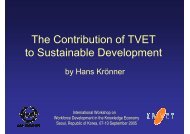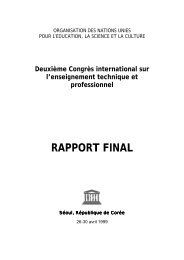Learning for Life, Work and the Future Initial ... - Unesco-Unevoc
Learning for Life, Work and the Future Initial ... - Unesco-Unevoc
Learning for Life, Work and the Future Initial ... - Unesco-Unevoc
You also want an ePaper? Increase the reach of your titles
YUMPU automatically turns print PDFs into web optimized ePapers that Google loves.
<strong>Learning</strong> <strong>for</strong> <strong>Life</strong>, <strong>Work</strong> <strong>and</strong> <strong>the</strong> <strong>Future</strong> Participants’ Papers Page 51<br />
9. The World of <strong>Work</strong><br />
VET institutions should be aligned with <strong>the</strong> needs of<br />
<strong>the</strong> world of work if <strong>the</strong>y are to succeed with access.<br />
The purpose <strong>and</strong> primary objective of vocational<br />
education <strong>and</strong> training is to provide its clientele with<br />
post-school preparation <strong>for</strong> occupation in <strong>the</strong> <strong>for</strong>mal or<br />
in<strong>for</strong>mal sector of <strong>the</strong> economy, ei<strong>the</strong>r as an employee<br />
or self-employed. If VET institutions do not meet this<br />
primary objective, prospective c<strong>and</strong>idates are denied<br />
<strong>the</strong> opportunity to enrol with <strong>the</strong>m.<br />
In this world of science <strong>and</strong> technology, where equality<br />
of sexes, social justice <strong>and</strong> human rights are popular<br />
topics in various international <strong>for</strong>a <strong>and</strong> studies, it is<br />
ra<strong>the</strong>r disturbing to note that <strong>the</strong>re is still a disparity<br />
between <strong>the</strong> participation of men <strong>and</strong> women, especially<br />
in scientific <strong>and</strong> technological fields. Invariably<br />
<strong>the</strong>re is still low participation of women in a number of<br />
occupational <strong>and</strong> social roles that are at <strong>the</strong> moment<br />
accorded higher status <strong>and</strong> income. Women represent<br />
a relatively small percentage of students in <strong>the</strong> vocational<br />
institutions in Botswana.<br />
The success of any economy depends on <strong>the</strong> effective<br />
utilisation of its human resources, which calls <strong>for</strong> <strong>the</strong><br />
equal participation of both men <strong>and</strong> women. Un<strong>for</strong>tunately,<br />
scientific <strong>and</strong> technological careers have<br />
traditionally been <strong>the</strong> domain <strong>and</strong> preserve of men.<br />
The major questions to ask regarding this phenomenon<br />
are: What hinders women from participating fully in<br />
<strong>the</strong>se careers? Is it because women are not mechanically<br />
or technically inclined? Or is it that women are<br />
not capable of thinking <strong>and</strong> working scientifically?<br />
How far is <strong>the</strong> socialisation process a contributory<br />
factor?<br />
10. The Current Situation of Technical <strong>and</strong><br />
Vocational Institutions in Botswana<br />
The Government of Botswana is committed to <strong>the</strong><br />
adoption of gender equality in all policies <strong>and</strong><br />
programmes nationally, regionally <strong>and</strong> internationally.<br />
Equal access has been emphasised at all levels of<br />
education <strong>and</strong> training, as reflected in <strong>the</strong> 1977<br />
National Commission on Education, <strong>the</strong> Revised<br />
National Policy on Education (1994), <strong>the</strong> National<br />
Development Plan 8 <strong>and</strong> o<strong>the</strong>r reports. Significant<br />
developments have been made to achieve access,<br />
including:<br />
• Mushrooming of schools, especially at junior<br />
secondary school level<br />
• Education <strong>and</strong> training of large numbers of teachers<br />
<strong>and</strong> lecturers both locally, regionally <strong>and</strong> abroad<br />
• Expansion of Vocational Training Centres, now<br />
called Technical Colleges<br />
• Upgrading of Brigades<br />
• The interim programme <strong>for</strong> <strong>the</strong> training of lecturers<br />
at CTVE that is already under way<br />
• Formulation of policies on equal opportunities<br />
admissions, pregnancy <strong>and</strong> o<strong>the</strong>rs.<br />
However, in spite of all <strong>the</strong>se ef<strong>for</strong>ts, we still find<br />
gender disparities, not only in education circles, but<br />
also in <strong>the</strong> employment sector. For example, in 1994,<br />
females constituted only 33% of <strong>the</strong> entire enrolment<br />
in VET institutions.<br />
11. Problems of Access<br />
There are a number of factors that lead to <strong>the</strong> everescalating<br />
gender disparities, as described below:<br />
Career in<strong>for</strong>mation fails to reach <strong>the</strong> target<br />
population:<br />
Several reasons can be found <strong>for</strong> this, such as lack of<br />
personnel to do this task. In <strong>the</strong> secondary schools,<br />
<strong>the</strong>re are teachers who serve as guidance teachers <strong>and</strong><br />
are remunerated <strong>for</strong> <strong>the</strong> job, but this is not <strong>the</strong> case at<br />
our TVE institutions.<br />
Attitudes<br />
Age restriction<br />
Composition of interview panels<br />
Lack of trained guidance <strong>and</strong> counselling personnel<br />
Not enough assistance to make students realise that<br />
VET is a viable option.<br />
Inadequate selling of <strong>the</strong> institution to <strong>the</strong><br />
community<br />
Gendered power relations<br />
The tables below show how <strong>the</strong> governance of <strong>the</strong>se<br />
institutions is biased towards men, who occupy most of<br />
<strong>the</strong> top positions. Not all <strong>the</strong> institutions are implicitly<br />
gendered, <strong>for</strong> socio-cultural or historical reasons, but<br />
this kind of scenario obviously has some impact on<br />
female retention in <strong>the</strong>se institutions as <strong>the</strong> men make<br />
all <strong>the</strong> decisions.<br />
Position Male Female Total<br />
Principal 1 0 1<br />
Deputy Principal 1 0 1<br />
HODs 4 1 5<br />
Lecturer I 7 1 8<br />
Lecturer II 15 4 19<br />
Bursar 1 0 1<br />
Supplies Officer 0 1 1<br />
Palapye Technical College





